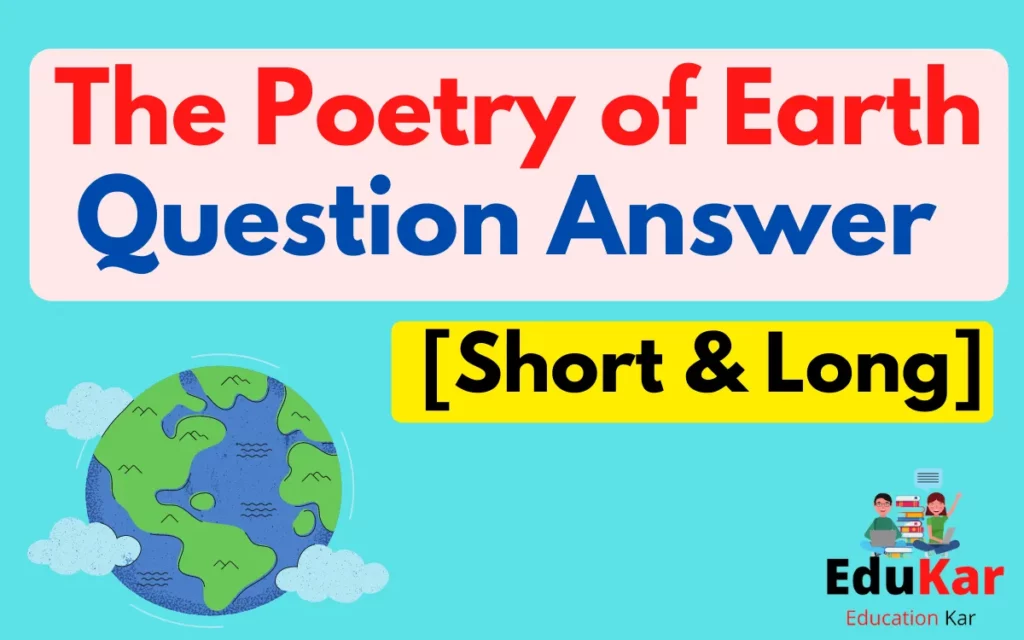| Name | Natural Vegetation and Wildlife |
| Type | Poem |
| Class | 12th |
| Subject | English |
| Board | WB Board |
| Author | John Keats |

The Poetry of Earth Summary
“The Poetry of Earth” is a poem written by John Keats, an English Romantic poet. The poem is about the beauty of nature and how it has the power to inspire poetry and art. It reflects the poet’s deep appreciation for the natural world and its ability to evoke emotion and imagination.
The poem begins with the poet expressing his love for the natural world, describing how the beauty of nature is the source of his inspiration. He goes on to say that the poetry of earth is never dead, as it is constantly renewed by the changing seasons and the cycles of nature. He emphasizes the idea that the beauty of nature is eternal, and that it will always inspire poets and artists to create beautiful works of art.
The poem then goes on to describe the different aspects of nature that inspire the poet, such as the songs of birds, the colors of flowers, and the scents of the earth. The poet also reflects on the way nature reflects the moods and emotions of man, and how it can be used as a way to understand and express human feelings.
The poem concludes with the poet expressing his belief that the beauty of nature will always be a source of inspiration for poets and artists, and that it will continue to evoke emotion and imagination in the hearts of men. The poem is a celebration of the beauty of nature and its ability to inspire poetry and art.
The Poetry of Earth Question Answer
Q1: Identify the voices of the “Poetry of Earth”. How does Keats establish its continuity through these voices.
Ans: In John Keat’s poem “The Poetry of Earth” the voices of the Grasshopper and the Cricket are presented as the voices of the ” Poetry of Earth”. The Grasshopper sings in summer and the Cricket sings in winter.
In the poem “The poetry of Earth” the poet says that the poetry of earth is never dead. The poet shows very clearly that the poetry or music in nature continues through the changes of seasons. In summer when the birds are faint with the hot sun and hide in the shade of cooling trees, the Grasshopper carries the music of earth. His voice is heard from the hedge to hedge and in the new-mown mead. He takes the main role to continue the music in summer luxury. In winter when the frost creates a silence the cricket shrills from the stove. One who is half lost in drowsiness mistakes the cricket’s song as the song of Grasshopper. Thus rhe nusic of earth never ceases. It continues through the changes of seasons.
Q2: How does Keats show that the “poetry of earth” never cease?
Ans: In the poem “The Poetry of Earth” the poet says that the poverty of Earth is never ending. The poet shows very clearly that the poverty or music in nature continues through the changes of seasons. In summer when the birds are faint with the hot sun and hide in the shade of cooling trees, the Grasshopper carries the music of earth. His voice is heard from the hedge to hedge and in the new mown mead. He takes the main role to continue the music in summer luxury. In winter when the frost creates a silence, the cricket skrills from the stove. One who is half lost in drowsiness mistakes the cricket’s song as the song of Grasshopper. Then the music of earth never ceases. It continues through the changes of seasons.
Q3: Justify the title of the poem” The Poetry of Earth”.
Ans: The title of the poem “The poetry of Earth” refers to the continuous music of nature. “The poetry of earth ” means poem or music of earth. In the poem “The Poetry of Earth” the poet says that the poetry of earth is never dead. The poet shows very clearly that the poetry or music in nature continues through the changes of seasons. In summer when the birds are faint with the hot sun and hide in the shade of cooling trees, the Grasshopper carries the music of Earth. His voice is heard from hedge to hedge and in the new mown mead. He takes the main role to continue the music in summer luxury. In winter when the frost creates a silence, the cricket shrills from the stove. Thus the music of earth never ceases. It continues through change of seasons. Hence the title is appropriate.
Q4: What picture of summer is presented in ” The Poetry of Earth”? How has it been carried onto the picture of winter?
Ans: A musical picture of summer is presented in “The Poetry of Earth”. The poet shows that the poetry or the music of earth never ceases. It continues through teh changes of seasons. In summer when the birds are faint with the hot sun and hide in the shade of cooling trees, the Grasshopper carries the music of Earth. His voice is heard from one hedge to other and in the new mown mead, He takes the main role to continue the music in summer luxury.
In a lone winter when the frost creates a silence, the cricket shrills from the stove. One who is half lost in drowsiness mistakes the cricket’s song as the song of Grasshopper. Thus the music of earth never ceases. It continues throught the changes of seasons.
Q5: Identify the voices of the “poetry of Earth”. How does Keats establish its continuity through its voices? [H.S. 2020]
Ans: The voices of “The Poetry of Earth” in Keats sonnet are the grasshopper and the cricket. In this poem Keats uses a great continuity by connecting up the song of the grasshopper in summer with the song of the cricket in winter. So, the music of nature is never silent. In scorching heat when all the birds become exhausted and take rest in shadowy trees, grasshopper runs singing from hedge to hedge. He takes lead in summer enjoyment. When he is tired, he takes rest beneath some pleasant weed. On a quiet winter evening, from behind the stove, there is the chirping of the cricket. To one who is sitting over the time, half asleep. It seems to be the continuation of the grasshopper’s song.
Q6: “He has never done with his delights”. Who is referred to? What does he do? What does the extract mean?
Ans: The grasshopper in Keats poem “The Poetry of the Earth” is refererd to here. Out of joy the grasshopper runs about singing in the scorching heat of the sun. It runs from hedge to hedge. When all the birds take retire from singing and take shelter in the cooling of the trees, the grasshopper moves from hedge to hedge out of sheer joy in the scorching heat of the sun and takes the responsibility to fill the void of music. It moves about the newly mown mead singing joyfully. Playing, singing, resting are his delights. He finds summer pleasant. He is not exhausted by the scorching heat of sun, rather he loves the sunshine. So he has never dined with its delight.
The Poetry of Earth Short Question Answer
Q1: What does Keats celebrate in the “The Poetry of Earth”?
Ans: In “The Poetry of Earth” Keats celebrate the never ending music of nature.
Q2: Why are the birds exhausted?
Ans: The birds are exhausted from the extreme heat of sun.
Q3: “A voice will run”- whose voice is it?
Ans: It is grasshopper’s voice.
Q4: Where does grass hopper takes rest beneath some pleasant weed.
Ans: The grasshopper takes rest beneath some pleasant weed.
Q5: Which two seasons come into description in “The Poetry of Earth”?
Ans: In”The poetry of Earth” the two seasons come descriptions are- Summer and Winter.
Q6: What is the man half in sleep reminded of?
Ans: The man half in sleep is reminded of the grasshopper among some grassy hills.
Q7: Who enjoys the summer best?
Ans: The grasshopper enjoys the summer best.
Q8: Who hide in cooling trees?
Ans: The tired birds hide in cooling trees.
Q9: Whose delight is never done with?
Ans: Thegrasshopper’s delight is never done with.
Q10: What shrills from the kitchen stove?
Ans: The cricket’s voice shrills from the kitchen stove.
Q11: Where is the song of the grasshopper heard?
Ans: The song of the grasshopper is heard from hedge to hedge about new-mown meadow.
Q12: What was wrought a silence in winter?
Ans: The frost has wrought a silence in winter.
Q13: From where does the cricket’s song come?
Ans: The cricket’s song comes from the kitchen stove.
Q14: Whose voice runs from hedge to hedge?
Ans The grasshopper’s voice runs from hedge to hedge.
Q15: What happens to the birds in summer?
Ans: The birds get tired and faint from the excessive heat of summer.
Q16: What is increasing warmth in the winter evening?
Ans: The cricket’s song is increasing warmth in the winter evening.
Q17: What type of sonnet is the poem “The Poetry of Earth”?
Ans: “The Poetry of Earth” is a Petrarchan sonnet.
Q18: Who are the carriers of this music in “The Poetry of Earth”?
Ans: The birds, the grasshopper and the cricket are the carriers of this music in “The Poetry of Earth”.
Q19: When will the poetry of Earth end?
Ans: The poetry of Earth will never end.
Q20: Who refuse to sing in hot summer?
Ans: Birds refuse to sing in hot summer.
Q21: Where does the bird hide to escape the scorching heat of summer?
Ans: The bird hides in cooling trees to escape the scorching heat of the summer.
Q22: In which season is the grasshopper’s presence felt?
Ans: The grasshopper’s presence is felt in the summer season.
Q23: “How is the winter evening in “The Poetry of Earth”?
Ans: The winter evening is lonely and frosty in “The Poetry of Earth”.
Q24: What is meant by “new-mown mead”?
Ans: “New mown mead” means the meadows from where the crops are freshly cut.
Q25: Where from does the cricket draw heat?
Ans: The cricket draws heat from the kitchen stove.
Q26: Why is the winter evening lone?
Ans: The winter evening is lone because of extreme cold weather.
Q27:What does Keats make the voices of grasshopper and the cricket follow each other?
Ans: Keats makes the voices of grasshopper and the cricket follow each other to create the impression that the music of Earth never ceases. One takes the lead from another.
Q28: What does someone feel in drowsiness in the poem “The Poetry of Earth”?
Ans: Someone feels drowsiness that the shrill of the cricket is overlapping with the voice of the grasshopper among some grassy hill.


![Natural Vegetation and Wildlife Class 9 Questions Answers [Class 9 Geography Chapter 5] Natural Vegetation and Wildlife Questions Answers](https://edukar.org/wp-content/uploads/2023/01/Natural-Vegetation-and-Wildlife-Questions-Answers--1024x640.webp)

![Deep Water MCQ [English Chapter 3-Class 12 CBSE] Deep Water MCQ](https://edukar.org/wp-content/uploads/2022/12/deep-water-mcq-1024x640.webp)



![Asleep in the Valley Questions and Answers 2023 [Class 12-English] Asleep in the Valley Questions and Answers](https://edukar.org/wp-content/uploads/2022/12/Asleep-in-the-Valley-Questions-and-Answers-1024x640.webp)

![Stopping By Woods On A Snowy Evening [Summary & Questions answers] stopping-by-woods-on-a-snowy-evening-question-answer](https://edukar.org/wp-content/uploads/2022/12/stopping-by-woods-on-a-snowy-evening-question-answer-1024x640.webp)
![How To Tell Wild Animals Questions and Qnswers [English Class 10 Chapter 4] How To Tell Wild Animals Questions and Qnswers [English Class 10 Chapter 4]](https://edukar.org/wp-content/uploads/2023/01/How-To-Tell-Wild-Animals-Questions-and-Qnswers-1024x640.webp)


![Lost Spring MCQ [Class 12 English Flamingo Chapter 2] Lost Spring MCQ](https://edukar.org/wp-content/uploads/2022/12/Lost-Spring-MCQ-Class-12-English-Flamingo-Chapter-2-1024x640.webp)
